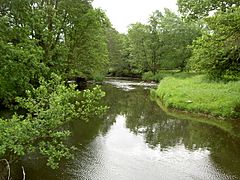River Alyn facts for kids
Quick facts for kids Alyn |
|
|---|---|

The River Alyn near the town of Hope.
|
|
| Native name | Afon Alun |
| Other name(s) | River Alun |
| Country | United Kingdom |
| Constituent country | Wales |
| Region | Denbighshire, Wrexham |
| City | Mold |
| Physical characteristics | |
| Main source | Llandegla Moors, Flintshire 53°02′13″N 3°12′48″W / 53.03694°N 3.21333°W |
| River mouth | confluence with River Dee 53°05′54″N 2°53′58″W / 53.09833°N 2.89944°W |
| Discharge (location 2) |
|
| Basin features | |
| Tributaries | |
The River Alyn (called Afon Alun in Welsh) is a river in northeast Wales. It is a tributary, which means it's a smaller river that flows into a larger one. The River Alyn joins the River Dee.
The Alyn starts in the southern part of the Clwydian hills. The valley where the Alyn flows is a very special place. It is part of the Clwydian Range Area of Outstanding Natural Beauty. This means the area has amazing landscapes and is protected. The biggest town along the River Alyn is Mold, which is the main town of Flintshire. The river is so important that it even gives its name to local government areas like Alyn and Deeside.
Contents
Where the River Alyn Flows
From Hills to the Dee
The River Alyn flows over a type of rock called carboniferous limestone. It starts near Halkyn Mountain and goes north through the Loggerheads area. After that, it turns southeast and passes through the town of Mold. Finally, the River Alyn meets the River Dee to the northeast of Wrexham.
The Amazing Alyn Gorge
Between Loggerheads and Rhydymwyn, the River Alyn flows through a cool place called the Alyn Gorge. This gorge is home to some interesting caves. These caves include Ogof Hesp Alyn, Ogof Hen Ffynhonnau, and Ogof Nadolig.
Because the river flows over limestone, it creates special features. These include potholes and underwater caves. During the summer, when there is less rain, the water level in the river drops a lot. When this happens, the river actually flows into these caves! For some parts of the Alyn Gorge, the riverbed can be completely dry for most of the year.
How Mining Affects the River
The amount of water flowing in the River Alyn is greatly changed by mining activities. There is a large tunnel called the Milwr mine drainage tunnel. This tunnel takes a huge amount of water away from the River Alyn. It diverts about 23 million gallons of water every day! This water is moved out of the Alyn's natural path. Instead, it flows into the River Dee estuary near Bagillt.

